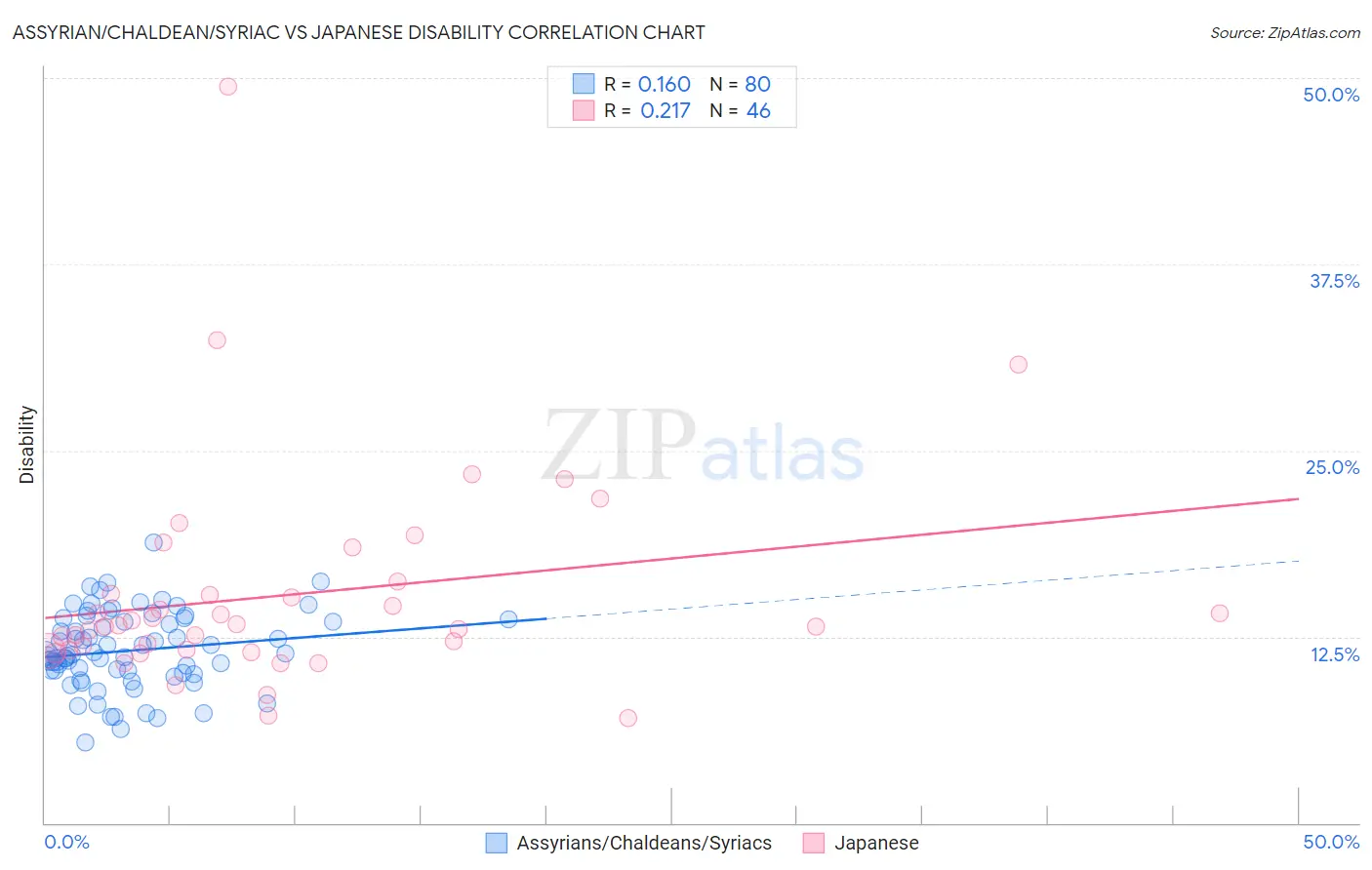Assyrian/Chaldean/Syriac vs Japanese Disability
COMPARE
Assyrian/Chaldean/Syriac
Japanese
Disability
Disability Comparison
Assyrians/Chaldeans/Syriacs
Japanese
11.9%
DISABILITY
12.6/ 100
METRIC RATING
201st/ 347
METRIC RANK
12.2%
DISABILITY
2.3/ 100
METRIC RATING
234th/ 347
METRIC RANK
Assyrian/Chaldean/Syriac vs Japanese Disability Correlation Chart
The statistical analysis conducted on geographies consisting of 110,312,508 people shows a poor positive correlation between the proportion of Assyrians/Chaldeans/Syriacs and percentage of population with a disability in the United States with a correlation coefficient (R) of 0.160 and weighted average of 11.9%. Similarly, the statistical analysis conducted on geographies consisting of 249,165,535 people shows a weak positive correlation between the proportion of Japanese and percentage of population with a disability in the United States with a correlation coefficient (R) of 0.217 and weighted average of 12.2%, a difference of 2.0%.

Disability Correlation Summary
| Measurement | Assyrian/Chaldean/Syriac | Japanese |
| Minimum | 5.4% | 7.1% |
| Maximum | 18.8% | 49.5% |
| Range | 13.4% | 42.4% |
| Mean | 11.6% | 15.3% |
| Median | 11.2% | 13.2% |
| Interquartile 25% (IQ1) | 10.1% | 11.6% |
| Interquartile 75% (IQ3) | 13.6% | 15.3% |
| Interquartile Range (IQR) | 3.5% | 3.8% |
| Standard Deviation (Sample) | 2.6% | 7.3% |
| Standard Deviation (Population) | 2.6% | 7.2% |
Similar Demographics by Disability
Demographics Similar to Assyrians/Chaldeans/Syriacs by Disability
In terms of disability, the demographic groups most similar to Assyrians/Chaldeans/Syriacs are Belizean (11.9%, a difference of 0.020%), Immigrants from England (12.0%, a difference of 0.070%), British West Indian (12.0%, a difference of 0.12%), Mexican American Indian (12.0%, a difference of 0.12%), and Immigrants from Panama (11.9%, a difference of 0.18%).
| Demographics | Rating | Rank | Disability |
| Somalis | 17.3 /100 | #194 | Poor 11.9% |
| Barbadians | 15.8 /100 | #195 | Poor 11.9% |
| Serbians | 15.4 /100 | #196 | Poor 11.9% |
| Immigrants | Belize | 15.2 /100 | #197 | Poor 11.9% |
| Ukrainians | 14.7 /100 | #198 | Poor 11.9% |
| Immigrants | Panama | 14.6 /100 | #199 | Poor 11.9% |
| Belizeans | 12.8 /100 | #200 | Poor 11.9% |
| Assyrians/Chaldeans/Syriacs | 12.6 /100 | #201 | Poor 11.9% |
| Immigrants | England | 12.0 /100 | #202 | Poor 12.0% |
| British West Indians | 11.5 /100 | #203 | Poor 12.0% |
| Mexican American Indians | 11.4 /100 | #204 | Poor 12.0% |
| Immigrants | Western Europe | 10.1 /100 | #205 | Poor 12.0% |
| Immigrants | Senegal | 9.4 /100 | #206 | Tragic 12.0% |
| Immigrants | Thailand | 9.3 /100 | #207 | Tragic 12.0% |
| Immigrants | Caribbean | 9.1 /100 | #208 | Tragic 12.0% |
Demographics Similar to Japanese by Disability
In terms of disability, the demographic groups most similar to Japanese are Bahamian (12.2%, a difference of 0.030%), Yup'ik (12.2%, a difference of 0.040%), Italian (12.2%, a difference of 0.12%), Malaysian (12.2%, a difference of 0.13%), and Chinese (12.2%, a difference of 0.13%).
| Demographics | Rating | Rank | Disability |
| Alsatians | 3.3 /100 | #227 | Tragic 12.1% |
| West Indians | 2.9 /100 | #228 | Tragic 12.2% |
| Inupiat | 2.8 /100 | #229 | Tragic 12.2% |
| Samoans | 2.6 /100 | #230 | Tragic 12.2% |
| Malaysians | 2.5 /100 | #231 | Tragic 12.2% |
| Italians | 2.5 /100 | #232 | Tragic 12.2% |
| Bahamians | 2.3 /100 | #233 | Tragic 12.2% |
| Japanese | 2.3 /100 | #234 | Tragic 12.2% |
| Yup'ik | 2.2 /100 | #235 | Tragic 12.2% |
| Chinese | 2.0 /100 | #236 | Tragic 12.2% |
| Immigrants | Congo | 1.9 /100 | #237 | Tragic 12.2% |
| Norwegians | 1.9 /100 | #238 | Tragic 12.2% |
| Swedes | 1.8 /100 | #239 | Tragic 12.2% |
| Hungarians | 1.7 /100 | #240 | Tragic 12.2% |
| Yugoslavians | 1.7 /100 | #241 | Tragic 12.2% |